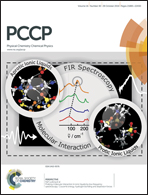Introducing asymmetry in tetradentate azadipyrromethene chromophores: a systematic study of the impact on electronic and photophysical properties†
Abstract
As analogues of the porphyrinoid and dipyrromethene families of dye, azadipyrromethene (ADPM) derivatives exhibit exciting photophysical properties. Their high absorbance (ε up to 100 000 M−1 cm−1) in the yellow-to-red region and the strong NIR luminescence encountered in boron-chelated aza-BODIPY analogues are especially interesting in the context of light-harvesting and life science applications. In the present study, we endeavoured to compare symmetric and asymmetric tetradentate ADPM derivatives 1–6versus two related bidentate ADPM references in order to gain insights into their structure–property relationship. This is of interest since the tetradentate motif opens the way for extended π-conjugation through metal-mediated planarization, in a bio-mimicry fashion of metalloporphyrinoids, and is known to induce a bathochromic shift toward the NIR. A new straightforward synthetic approach is used to access asymmetric derivatives 4–6 that avoids the tedious heterocycle formation of nitroso-pyrrole intermediates. In addition, photophysics, electrochemistry, computational modelization (DFT and TD-DFT) and X-ray structural characterization of ADPMs are used to better understand the potential of these new chromophores.


 Please wait while we load your content...
Please wait while we load your content...